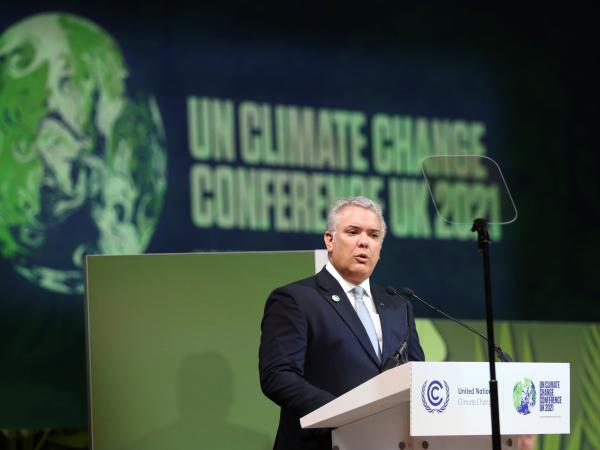Within the framework of Annual Conference on Climate Change (COP26), the President of the Republic, Iván Duque, presented the strategy to mitigate climate change by 2050, a project whose main objective is for the country to emit a maximum of 169.44 million tons of carbon dioxide in 2030, and thus reach carbon neutrality in the next 30 years.
To achieve this, the roadmap includes 9 action points, with specific objectives for 2050; commitments that will be assumed by 7 governments.
(See: Companies and COP26).
The first consists of expand climate knowledge to the entire population so that local, regional and national governments can make decisions. For this, the country will have 100% coverage of the territory with hydrometeorological information that will help the population adapt to climate change.
The second plan of action is sustainable management of resources and protection of biodiversity. Colombia must achieve zero deforestation and non-degradation of native ecosystems, at least 4.25 million hectares. Likewise, at least 1.3 million hectares of ecosystems in critical condition must be restored.
(See: Colombia will receive more than $ 1.5 billion to reforest the Amazon).
The third bet of the Nation contemplates sustainable production and consumption. One of its pillars is to achieve the following material utilization rates: 50% cement and concrete, 60% plastic, 90% steel, between 40% and 50% glass and wood. Finally, it is to ensure that 50% of textiles have a post-consumer useful life.
Within this objective, there are articulated actions to promote green businesses. As well as promoting the innovation of intelligent designs for the reuse of materials. On the other hand, in this commitment the Government intends that the agricultural sector, by 2050, use technologies and best practices that increase its competitiveness.
SOCIAL INITIATIVE
The fourth objective is a social bet, It addresses employment from a perspective of justice and new learning oriented to climate change. For example, increase the number of undergraduate (technical, technological and professional) and graduate programs that contribute to carbon neutrality. As well as promoting the formalization of employment in the most vulnerable sectors towards a resilient economy.
(See: Only 27.5% of companies in Colombia measure their carbon footprint).
One of the most important bets, taking into account that greenhouse gas emissions from land use are the ones with the highest percentage in the country, is rural development, adapted to climate change. In this segment, the Government set goals such as the liberation of between 20% and 40% of the land used for cattle ranching and allocating it for the restoration of natural ecosystems and forest plantations. Also, by 2050, crops of importance for food security and exports will increase their productivity between 30% and 50%.
Another of the strategy bets is focusing on cities and regions. The axis of this action is in an integral urban development, not only for environmental sustainability, but also for the promotion of diversity, connectivity and productivity, thus achieving an efficient management of resources and climate change.
One of the most important axes of the plan is that of rural development.
This will be sustained in actions of orderly urban growth and effective local and regional planning, management of resources and waste in favor of the circular economy, more efficient mobility systems and buildings adapted to climate change.
(See: Government will create two new protected areas for the country’s oceans).
The seventh action that the 30-year climate plan focuses on is to achieve a diversified energy matrix, that, on the one hand, meet the demand through renewable sources, and on the other, allow access to clean resources and more efficient technologies. In 2050, Colombia expects the electrification of the matrix to go from 18% to 26%, despite the fact that the path towards carbon neutrality points to figures between 40% and 70%.
Sustainable mobility and infrastructure make up another axis of the strategy. The country proposes to move towards transport systems not dependent on fossil fuels, continue with the process of disintegration of vehicles to reduce the circulation of equipment with polluting technologies to at least 70% of them in 2035, while for air transport and airports it is sought promote the reduction of emissions and restrict those aircraft that exceed the limits defined by technological surveillance.
The last bet is on increase the adaptive capacity of the population and the health system in the event of events sensitive to variability and change in climate in conjunction with the social and environmental determinants of health.
DUQUE, AT COP26
While one of the most important items on the president’s agenda at COP 26 was the presentation of the strategy, the president has also made several announcements. On his agenda yesterday, he participated in the Plenary of the summit, where he highlighted the actions that Colombia is promoting in climate matters.
(See: Bezos will support the creation of the world’s largest marine protected area).
Likewise, Duque announced the extension of marine protected areas in the Marine Corridor in the Eastern Tropical Pacific, a joint action between Colombia, Costa Rica, Ecuador and Panama. The president also celebrated the signing of an agreement for the financing of up to US $ 1,200 million with the IDB and held his first official meeting with the President of the United States.
BRIEFCASE







